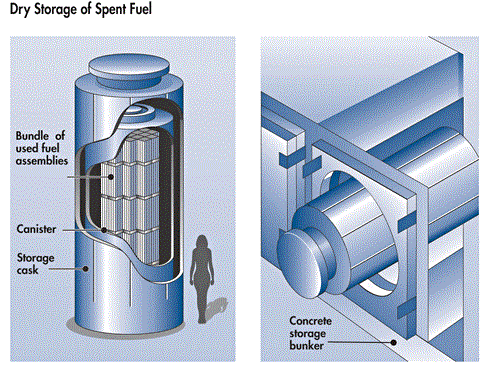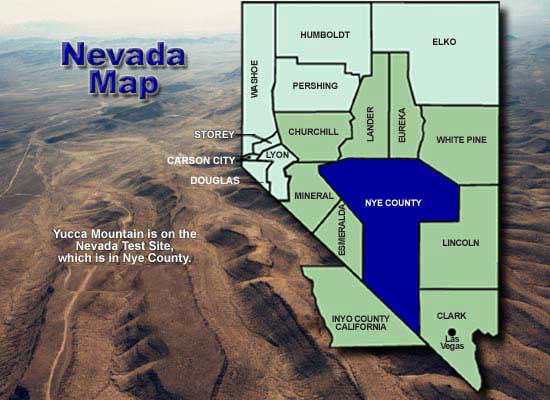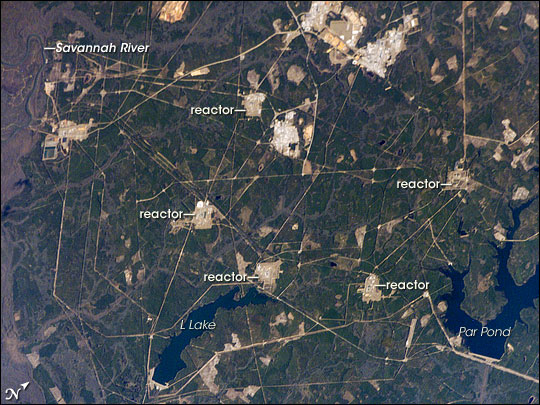7.11: Transporting and Storage of Nuclear Waste
- Page ID
- 85516
Waste from Uranium Production
The tailings or waste produced by the extraction or concentration of uranium from its ore contain radioactive isotopes of uranium, thorium, and radium as well as significant concentrations of heavy metal including chromium, lead, molybdenum, and vanadium. More than 200 pounds of tailings are produced for each pound of uranium. This sandy waste material must be contained in carefully monitored sites known as tailings piles (Figure \(\PageIndex{1}\)).

Uranium production processes do not affect the level of radioactivity and do not produce significant chemical waste. An enrichment process for one ton of uranium hexafluoride produces 130 kg of UF6 (3.5% U-235) and 870 kg of depleted UF6 containing U-238. Depleted uranium has few applications. However, its high density 18.7 g/cm3 makes it useful in armor plating and radiation shielding. In addition, depleted uranium is a potential energy source for fast breeder reactors.
Waste from Nuclear Power Generation
In the open fuel cycle, the spent fuel rods remain in the pools under at least 20 feet of water. This aqueous layer protects the surroundings from radiation. Currently, most reactor sites in the United States utilize this type of storage. The Nuclear Regulatory Commission (NRC) requires all facilities to store spend fuel rods at least three years under water. Most nuclear plants will keep rods in water up to around ten years and then transfer waste to a dry system (cask).

Once fuel rods are removed from the pool, they are placed in a cylinder in a chemically inert atmosphere of helium gas (Figure \(\PageIndex{3}\)). The cylinder is then sealed and encased in steel and concrete to contain the radiation and enhance security for storage or transportation to a permanent repository. All nuclear power plants are allowed to use dry cask storage on site. If a facility is full, then dry fuel rods can be transferred to a decommissioned nuclear power plant. Rods stored on or off site can be transported to a temporary consolidated storage site.

At this time (2017), there is no permanent location in the United States that will store nuclear power waste.
In 2009, the total amount of nuclear waste generated by reactors was 62,683 metric tons. Seventy eight percent of this waste is in wet storage. The remaining twenty two percent is contained in dry cask. Annually, United States' reactors produce between 2000-2400 tons (1 ton = 2000 pounds) of nuclear waste. To understand this amount of weight, view the vehicle below. Built by Ford Motor Company, the 2017 version of the all wheel drive Edge weighs 4,060 pounds (Figure \(\PageIndex{4}\)). This amount is relative in size to the total amount of nuclear waste generated by all United States reactors in one year.

Nuclear waste is radioactive waste, meaning that it spontaneously emits radiation. It usually originates from the by-products of nuclear reactions in applications such as medicine and research. Radioactive waste degrades with time, releasing alpha, beta, and gamma radiation that pose many health risks to the environment and most organisms, including humans. Due to the harmful nature of nuclear waste, there is strict government regulation on the safe disposal of it. There are several types of waste, and as such, many different ways of discarding it.
Closed or Open Fuel Cycle?
Spent fuel in the open and closed fuel cycles generates radioactive waste. The components of spent reactor fuel can either be treated as waste (in the open fuel cycle) or reprocessed (in the closed fuel cycle). At this time, the United States has a open nuclear fuel cycle. This means that once nuclear fuel has been used it will be stored in ponds or casks. Other countries close their fuel cycles. . In other words, the waste from fuel rods is extracted and reprocessed to be reused again for fuel or for nuclear weapons.

The controversy behind nuclear technology is due to the radioactive waste it creates. Some elements used in nuclear reactors have extremely long half-lives and must be shielded from humans and the environment for thousands of years. For example, plutonium-239, an isotope used in the production of nuclear weapons, has a half-life of 24,200 years while uranium-235 Hiroshima has a half-life of 700 million years. These elements emit large quantities of radioactivity that is extremely dangerous. Too much exposure can be followed by Acute Radiation Syndrome (ARS), which includes skin burns, nausea, vomiting, and eventually death within days if the exposure and dosage of radiation is high.
All Sources of Nuclear Waste
There are currently a number of nuclear productions that result in radioactive waste.
- Nuclear Weapons: From the weapons to the tools and machinery used in its production, proportional amounts of radioactivity can be found in all of them. After their use, these contaminated items must be disposed of while the radioactivity slowly degrades.
- Medicine and Research Applications: X-rays and other disease detecting technology in the medical field also consist of radiation albeit in a less harmful amount. For example, technetium-99m is an isomer that can be consumed to allow doctors to take images of the body’s process. However, even the syringes contribute to the problem of nuclear waste
- Nuclear Power: Most radioactive waste comes from the nuclear power plants situated around the world. There is a 20-30 ton waste that comes from each nuclear reactor every month it is in use.
- Agriculture: Nuclear power is also used in eliminating bacteria through the disruption of their genetic structure. This insures that they can no longer proliferate and grow in the food.
Classification of Nuclear Waste
There are three different types of radioactive waste that result from nuclear applications in the United States:
- Low Level Waste (LLW) – waste that is usually results from medicine or other industrial uses such as tools, rags, medical tubes, protective clothing, and others. There are three facilities in the U.S. that handle low-level waste by land disposal. This waste is shipped to four compact states in the country.

2. High Level Waste (HLW) – is the highly radioactive waste resulting from spent nuclear fuel from production or power reactors, as well as from the chemical processing of spent nuclear fuel and irradiated target assemblies Nuclear weapon components consisting of Pu-239 or U-235 are also classified as being high level waste. Because of the level of contamination, the waste must stored for long periods of time at some sort of geological repository. It is not uncommon for spent nuclear fuel to be stored underwater. HLW is currently being stored at the ninety-nine reactors sites, Hanford, WA, and Savannah River Site (Aiken, SC)
3. Uranium Mill Tailings – this category of waste comes from remains after extracting uranium from its natural ore. Large amounts are currently left out in the open of abandoned mining sites. However, if it remains uncovered and not disposed of correctly, the waste can mix with the sand and travel to water sources, polluting the environment to a great extent.
The highly radioactive liquid waste from reactors used to produce plutonium for the nuclear weapons of the United States is stored in tanks at the Hanford, Washington, and Savannah River, South Carolina. The Hanford site manages the largest volume of high-level waste, but the Savannah River site contains more total radioactivity. At Hanford, high-level waste alkaline liquid, salt cake, and sludge are stored in 149 single-shell and 28 double-shell underground tanks, while Savannah River has 51 tanks. These tanks contain approximately 88 million gallons of liquid, which is not only radioactive but also chemically toxic. The composition of the liquid varies from tank to tank. These facilities produced a combined total of 120 tons of plutonium for 20,000 nuclear warheads.
Management of Nuclear Waste
- Deep Geological Repository: This method is currently still being tested and facilities are being built. The idea is to seal the radioactive waste into special casks and to deposit them hundreds meters deep into a geographically stable area to allow it to decay. There is currently only one facility in the U.S. but a few more located around the globe.
- Transmutation: at the moment researchers are searching for a method to transmute the dangerous material into something less harmful, making it easier to dispose.
- Re-use: Currently, there is a Canadian patent to filter the waste and reuse whatever material that has not been altered. However, this practice requires a substantial amount of energy and is still in the very early stages of development.
- Space disposal: This has the best alternative to geological repositories because the waste can no longer harm the environment on earth. Of course, there are significant consequences of shooting radioactive waste into space such as damaging space shuttles and pollution. At the same time, space disposal would have to be agreed upon internationally.
Possible HLW Storage in the United States
In 1982, the Nuclear Waste Policy Act required the Department of Energy (DOE) to remove spent fuel from all United States' reactor sites by 1988. Unfortunately, this has not occurred yet. As a result, nuclear facilities have been awarded a total of five billion dollars (2015) to keep their waste fuel on campuses. These monies originated from a taxpayer fund.
In 1987, the DOE was encouraged to investigate an area that could house significant amounts of HLW radioactive waste. By the year 2001, the Department of Energy had spent nine billion federal dollars on their research. They selected Yucca Mountain, located about 100 miles northwest of Las Vegas, Nevada. This chosen site is arid, geographically stable, and remote. In addition, the waste would be store 1000 feet below dry rock and 1000 feet above the water table. It was hoped that this national geological repository would receive both high-level spent nuclear fuel from civilian power plants and defense-related activities (Figure \(\PageIndex{8}\)). T

As of 2017, all high level waste is being stored at 131 different locations. Thirty-nine states and sixty-six reactor sites utilize above and underground storage. Already, more than 3000 shipments of used reactor fuel has crossed over 1.7 million miles nationwide by tractor trailer or railcar.
Funding for the construction of Yucca Mountain was awarded by 2002. From 1983-2006, 13.54 billion dollars was spent on the study and construction of Yucca Mountain. In 2007, the NRC estimated the lifetime cost (this would include construction,transportation, and ultimate decommissioning of site) of Yucca Mountain would be 96.18 billion dollars. Federal funding for Yucca Mountain ended in 2011 for various reasons.
If Yucca were to start receiving waste, a railroad would need to be completed near the repository. The DOE estimates that an average of 175 rail and truck shipments annually could transport the 65,000 metric tons of waste. At this rate, this process would take twenty-four years.
Waste from Reprocessing Spent Fuel – The Closed Fuel Cycle
Reducing weapons grade Pu-239 has been a goal of both the United States and Russia. In 2000, both countries signed an agreement entailing that each country would dispose of 34 metric tons (1 metric ton = 2,205 pounds) of weapons grade plutonium. One approach to this would be to incorporate Pu-239 into reactor fuel. Current United States reactors would need to be altered for this alternative fuel. Pure weapon's grade Pu-239 would not be placed in a nuclear reactor. Instead, the material would undergo the MOX (mixed oxide) process. Excess plutonium (from weapons) can be combined with LEU (in oxide form) and placed in an altered reactor. This would decrease plutonium supplies as well as reduce required U-235 enrichment.
The MOX process can be applied to used U-235 fuel rods. The fission process process transmutates U-238 into Pu-239. If fuel rods are extracted safely from reactor, the plutonium can be isolated and combined into MOX fuel. Depending upon reactor design, MOX fuel can contain between 5 to 10% weapons grade plutonium Purified U-235 levels of MOX fuel would remain under 5%.
From 2005-2008, Duke Energy Corporation ran MOX in Catawba Nuclear Unit One reactor. This particular unit is located in York, South Caroline ( 18 miles south of Charlotte, NC). Protestors marched in opposition of MOX being used. In addition, the United States did not have a industrial plant to produce MOX. This fuel was fabricated by the company, AERVA MOX Services which is located in France. The United States would ship weapons grade plutonium out of Charleston Harbor across the ocean to this country. AERVA MOX Services would ship the fuel back to Charleston Harbor and tractor trailers would transport MOX to Catawba.
In 2007, the United States began construction on MOX facility at Savannah River Site (Aiken, South Carolina). Shaw AREVA MOX services consortium will build a Mixed Oxide Fuel Fabrication Facility (MFFF) to turn 3.5 tons/year of weapons grade plutonium into 150 MOX fuel assemblies. This company was awarded $2.7 billion for construction costs. At this time (2017), the United States' MOX facility is still being built.

MOX has been used by many countries. Most of the fuel is produced by France and the United Kingdom. Commercial (LW) reactors in France, Germany, Belgium, Switzerland, and the United Kingdom have used MOX for several years.
- What are the two ways nuclear reactor facilities store used fuel rods?
- What is HLW and LLW? How would radioactive medical waste, nuclear fuel waste, and nuclear bomb waste be classified?
- Can nuclear waste be chemically altered to reduce half-life?
- At this time, does the United States have an open or closed nuclear fuel cycle? Explain your answer.
- In the United States, where is the LLW stored?
- In the United States, where is reactor waste stored. Where is bomb waste stored?
- What is MOX? What is the purpose of using MOX?
- Does the United States use MOX fuel?
- How did the United States obtain MOX fuel?
- Where is MOX facility being built in the United States?
- What is Yucca Mountain? Where is located? Why was it selected for nuclear waste storage? Is it currently receiving nuclear waste? How would the waste be transported to this destination if it were to open?
- Answer
-
1. Nuclear fuel rods are first stored in a cooling pool above ground. After a couple of years, the cooled rods can be transferred to a dry, cask system.
2. HLW = high level nuclear waste and LLW = low level nuclear waste. Medical waste would be classified as being low level. Bomb and reactor waste are both high level. High level usually contains plutonium and/or uranium.
3. No, you cannot chemically alter a nucleus. Half-life cannot be changed by chemical means. One would have to transmute the waste to alter it.
4. The United States does not reprocess used fuel rods. This would be mean the fuel cycle is still open and rods must be stored. Other countries extract plutonium from fuel rods and use it for fuel. These countries would have a closed nuclear fuel cycle.
5. LLW is stored at four compact states: South Carolina, Texas, Utah, and Washington State.
6. Reactor waste is stored at commercial reactor sites (66 areas), Hanford, WA, and Aiken, SC (Savannah River Site). Bomb waste is stored at Hanford and Savannah River Site (SRS).
7. MOX stands for mixed oxide fuel. LEU is mixed with oxygen and plutonium to make a new type of fissionable fuel for commercial reactors. This helps reduce plutonium supplies and conserves uranium.
8. The United States did use MOX in the Catawba reactors. At this time, the United States does not use MOX fuel (we can't make it).
9. The United States shipped Pu-239 out of Charleston Harbor to France. AERVA corporation moxed fuel for us and shipped it back to Charleston. MOX was transported to the Catawba reactors (York, SC) by tractor trailer or railroad car.
10. A MOX facility is being built at SRS (Savannah River Site) in Aiken, SC.
11. Yucca is a hollowed out mountain that was designed to receive all HLW. It was selected due to climate, geography, and distance from people. It is not currently receiving waste due to governmental lawsuits. The waste would be transported from all reactors sites, Hanford, WA, and Aiken, SC by tractor trailer or railroad car (no planes!!!).
References
- Ojovan, M.I. An introduction to nuclear waste immobilisation. 1st. United Kingdom: Elsevier, 2005. Print.
- Scarborough, Kate. Nuclear Waste. United Kingdom: Franklin Watts, 2003. Print.
- http://www.yuccamountain.org/pdf/ocrwm_tslc-2008.pdf
Contributors and Attributions
Frank A. Settle (Washington and Lee University)
- Complete Bibliographies on Nuclear Waste from the Alsos Digital Library for Nuclear Issues
- Karen Chan (University of California, Davis)


